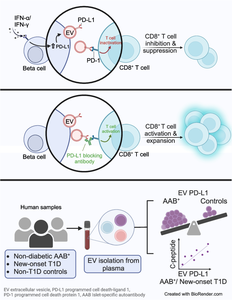Diabetologia ( IF 8.4 ) Pub Date : 2024-11-07 , DOI: 10.1007/s00125-024-06313-2 Chaitra Rao, Daniel T. Cater, Saptarshi Roy, Jerry Xu, Andre G. De Oliveira, Carmella Evans-Molina, Jon D. Piganelli, Decio L. Eizirik, Raghavendra G. Mirmira, Emily K. Sims

|
Aims/hypothesis
Surviving beta cells in type 1 diabetes respond to inflammation by upregulating programmed death-ligand 1 (PD-L1) to engage immune cell programmed death protein 1 (PD-1) and limit destruction by self-reactive immune cells. Extracellular vesicles (EVs) and their cargo can serve as biomarkers of beta cell health and contribute to islet intercellular communication. We hypothesised that the inflammatory milieu of type 1 diabetes increases PD-L1 in beta cell EV cargo and that EV PD-L1 may protect beta cells against immune-mediated cell death.
Methods
Beta cell lines and human islets were treated with proinflammatory cytokines to model the proinflammatory type 1 diabetes microenvironment. EVs were isolated using ultracentrifugation or size exclusion chromatography and analysed via immunoblot, flow cytometry and ELISA. EV PD-L1 binding to PD-1 was assessed using a competitive binding assay and in vitro functional assays testing the ability of EV PD-L1 to inhibit NOD CD8+ T cells. Plasma EV and soluble PD-L1 were assayed in the plasma of islet autoantibody-positive (Ab+) individuals or individuals with recent-onset type 1 diabetes and compared with levels in non-diabetic control individuals.
Results
PD-L1 protein co-localised with tetraspanin-associated proteins intracellularly and was detected on the surface of beta cell EVs. Treatment with IFN-α or IFN-γ for 24 h induced a twofold increase in EV PD-L1 cargo without a corresponding increase in the number of EVs. IFN exposure predominantly increased PD-L1 expression on the surface of beta cell EVs and beta cell EV PD-L1 showed a dose-dependent capacity to bind PD-1. Functional experiments demonstrated specific effects of beta cell EV PD-L1 to suppress proliferation and cytotoxicity of murine CD8+ T cells. Plasma EV PD-L1 levels were increased in Ab+individuals, particularly in those positive for a single autoantibody. Additionally, in Ab+ individuals or those who had type 1 diabetes, but not in control individuals, plasma EV PD-L1 positively correlated with circulating C-peptide, suggesting that higher EV PD-L1 could be protective for residual beta cell function.
Conclusions/interpretation
IFN exposure increases PD-L1 on the beta cell EV surface. Beta cell EV PD-L1 binds PD1 and inhibits CD8+ T cell proliferation and cytotoxicity. Circulating EV PD-L1 is higher in Ab+ individuals than in control individuals. Circulating EV PD-L1 levels correlate with residual C-peptide at different stages in type 1 diabetes progression. These findings suggest that EV PD-L1 could contribute to heterogeneity in type 1 diabetes progression and residual beta cell function and raise the possibility that EV PD-L1 could be exploited as a means to inhibit immune-mediated beta cell death.
Graphical Abstract
中文翻译:

β 细胞胞外囊泡 PD-L1 作为 CD8+ T 细胞活性的新型调节因子和 1 型糖尿病进化过程中的生物标志物
目标/假设
1 型糖尿病中存活的 β 细胞通过上调程序性死亡配体 1 (PD-L1) 来参与免疫细胞程序性死亡蛋白 1 (PD-1) 并限制自反应性免疫细胞的破坏来响应炎症。细胞外囊泡 (EV) 及其货物可以作为 β 细胞健康的生物标志物,并有助于胰岛细胞间通讯。我们假设 1 型糖尿病的炎症环境会增加 β 细胞 EV 货物中的 PD-L1,并且 EV PD-L1 可以保护 β 细胞免受免疫介导的细胞死亡。
方法
β 细胞系和人胰岛用促炎细胞因子处理,以模拟促炎性 1 型糖尿病微环境。使用超速离心或体积排阻色谱分离 EV,并通过免疫印迹、流式细胞术和 ELISA 进行分析。使用竞争性结合测定和体外功能测定评估 EV PD-L1 与 PD-1 的结合,以测试 EV PD-L1 抑制 NOD CD8+ T 细胞的能力。在胰岛自身抗体阳性 (Ab+) 个体或近期发作的 1 型糖尿病个体的血浆中测定血浆 EV 和可溶性 PD-L1,并与非糖尿病对照个体的水平进行比较。
结果
PD-L1 蛋白在细胞内与四跨膜蛋白相关蛋白共定位,并在 β 细胞 EVs 表面检测到。用 IFN-α 或 IFN-γ 处理 24 小时诱导 EV PD-L1 货物增加两倍,而 EV 数量没有相应增加。IFN 暴露主要增加了 β 细胞 EV 表面的 PD-L1 表达,β 细胞 EV PD-L1 显示出剂量依赖性结合 PD-1 的能力。功能实验表明,β 细胞 EV PD-L1 对抑制小鼠 CD8+ T 细胞的增殖和细胞毒性具有特异性作用。Ab+ 个体血浆 EV PD-L1 水平升高,尤其是在单一自身抗体阳性的个体中。此外,在 Ab+ 个体或 1 型糖尿病患者(但未在对照组个体中)中,血浆 EV PD-L1 与循环 C 肽呈正相关,表明较高的 EV PD-L1 可能对残留的 β 细胞功能具有保护作用。
结论/解释
IFN 暴露会增加 β 细胞 EV 表面的 PD-L1。β 细胞 EV PD-L1 结合 PD1 并抑制 CD8+ T 细胞增殖和细胞毒性。Ab+ 个体的循环 EV PD-L1 高于对照个体。循环 EV PD-L1 水平与 1 型糖尿病进展中不同阶段的残留 C 肽相关。这些发现表明,EV PD-L1 可能导致 1 型糖尿病进展和残余 β 细胞功能的异质性,并提高了 EV PD-L1 可能被用作抑制免疫介导的 β 细胞死亡的手段的可能性。






























 京公网安备 11010802027423号
京公网安备 11010802027423号